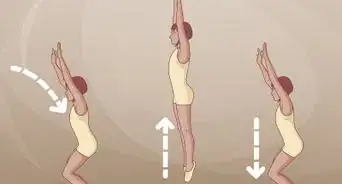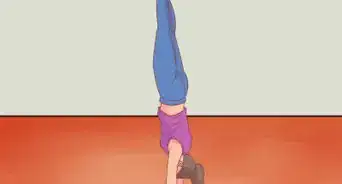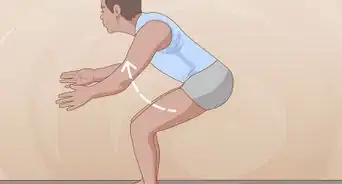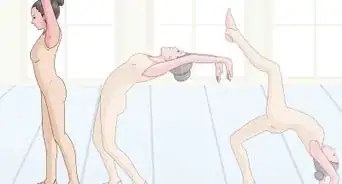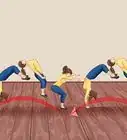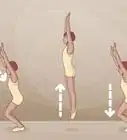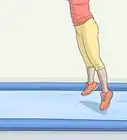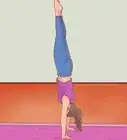This article was co-authored by Rosalind Lutsky, a trusted member of wikiHow's volunteer community. Rosalind Lutsky worked as a gymnastics coach at SB Gymnastics at Stanford University, coaching children from ages 5-12 years old during her time as a Stanford student. She was a competitive gymnast growing up, and competed for her local gymnastics team in Minnesota.
wikiHow marks an article as reader-approved once it receives enough positive feedback. In this case, several readers have written to tell us that this article was helpful to them, earning it our reader-approved status.
This article has been viewed 361,776 times.
Learn more...
The round off is a common skill in gymnastics for most tumbling passes. It can help if you’ve already learned How to Do a Cartwheel or how to Do a Handstand. The whole move only takes a few seconds, and prepares you for more advanced sequences that you can learn by taking gymnastics lessons.
Things You Should Know
- A round off is similar to a cartwheel, except you get a running start and you land on both feet facing the direction you started from.
- Begin by running and plant your dominant foot in the ground; use a quarter-turn to rotate your body sideways as you pull your upper body downward.
- Put your hands firmly on the ground as you spin and use the momentum of your lower body to carry you through a full rotation.
- Rotate your hips as you’re about to land and hop in the air to land on both feet at the same time.
Steps
Going into the Round Off
-
1Find your dominant side. You’ll step off from, and land on your dominant leg. It’s helpful to know which side of your body is your dominant side. Generally, it’s the hand you write with or kick a soccer ball with.
- This is the side you’ll want to use when you step off for your round off.
-
2Practice the quarter-turn action. The quarter-turn action is the beginning step of a round off before your last foot even leaves the floor. It helps to make sure you have the hip movement and hand placement right before moving into the rest of the round off.
- Your hands will form a diamond shape in the space between your forefingers and thumbs. This is for stability and safety.[1] It’s a good idea to practice hand placement before tackling the whole move.
- Since your hips will be rotating, it's a good idea to practice the rotation motion.
- To practice the quarter-turn:
- Face forward with your legs together, arms by your sides.
- Bend your dominant leg and lean forward with your weight on that leg.
- Reach your other leg behind you. Your torso should be parallel to the ground.
- Reach your arms out straight above your head.
- Place your dominant hand down onto the ground and rotate your hips, lifting the opposite leg high into the air.
Advertisement -
3Get a running start. With your dominant leg, start running into your round off. The momentum of starting with speed helps to get your legs into the air easier.
- Just before you start the round off, make sure you have a hurdle run. That means you’ll make a short skip with both legs bent before leaping into the round off.
- Keep your head tucked in, rather than up or out. This avoids an unnecessary arch in your back.
Doing the Round Off
-
1Step into the round off. After you’ve taken a step with your dominant leg (the skip from your running start), put your arms straight up in the air and step down onto the ground with that dominant foot.[2]
- Keep your leg bent while you step down.
- As you’re stepping down with your dominant leg, the other leg should be coming up behind you.
- Your hands should be out in front of you, palms open, waiting to catch your controlled fall.
-
2Control your form. For this part of the move, it’s important to keep your form controlled so you don’t injure yourself or wobble. This will speed up your learning and reduce practice time.
- Rotate your hips about 90 degrees.
- Make sure your back is straight as you step into the round off.
- Keep your eyes forward and down.
- As you reach your hands out in front of you, mold them into the T position so they’re ready for landing.
- Think quickly, you only have a few seconds to complete the entire move.
-
3Bring your legs up. As your body rolls forward, bring your back leg up over your head while reaching your non-dominant hand closer to the ground. Lift the dominant leg that’s touching the ground, straightening it.
- This all happens in one swift motion.
- Aim your non-dominant hand to land right next to your dominant hand. You want your forefingers and thumbs to be touching.
- As you bring your back leg up, keep your leg straight and strong.
-
4Place your hands on the ground. Set your non-dominant hand down on the ground next to your dominant hand, with the diamond shape between them.
- Make sure your back and hips are straight, feet pointed.
Landing the Round Off
-
1Pull your legs together. Now that both hands are on the floor supporting your weight, pull your legs together so that they’re touching.
- Pull your legs together just before they’re vertical in the air.[3]
- Keep your legs high in the air as you pull them together. Don’t lower or tuck them just yet.
-
2Rotate your hips. With your legs pulled together in the air, rotate your hips about 90 degrees. As you do this, your hands will start to come up off the ground. Your feet begin to make their way toward the ground behind you.
- You’re positioning yourself to land with both feet on the ground.
- Stop rotating when your body is aligned and you’re facing the direction you started from.
- You’re doing this as you’re in the air landing, so make your rotation as smooth as possible.
EXPERT TIP"Lift your chest up as you land, and push off the ground through your toes to get a big rebound."
Rosalind Lutsky worked as a gymnastics coach at SB Gymnastics at Stanford University, coaching children from ages 5-12 years old during her time as a Stanford student. She was a competitive gymnast growing up, and competed for her local gymnastics team in Minnesota.
Rosalind Lutsky
Former Gymnastics Coach Rosalind Lutsky
Rosalind Lutsky
Former Gymnastics Coach -
3Land on your feet. Push off with your hands, curving your back a little bit. Land on the ground with both feet at the same time. Bring your arms up over your head, next to your ears.
- Push through your shoulders, not your elbows.
- When you land, bend your knees a little bit to absorb some of the shock of the landing.
Expert Q&A
-
QuestionHow can I improve my round off?
 Rosalind LutskyRosalind Lutsky worked as a gymnastics coach at SB Gymnastics at Stanford University, coaching children from ages 5-12 years old during her time as a Stanford student. She was a competitive gymnast growing up, and competed for her local gymnastics team in Minnesota.
Rosalind LutskyRosalind Lutsky worked as a gymnastics coach at SB Gymnastics at Stanford University, coaching children from ages 5-12 years old during her time as a Stanford student. She was a competitive gymnast growing up, and competed for her local gymnastics team in Minnesota.
Former Gymnastics Coach Block with your hands — or, press off of the ground as you come out of your roundoff — to maintain your momentum.
Block with your hands — or, press off of the ground as you come out of your roundoff — to maintain your momentum. -
QuestionMy legs bend when I touch down -- what am I doing wrong?
 Community AnswerPush your legs up halfway and keep them in control. Keep practicing, as it takes a while to improve a round off.
Community AnswerPush your legs up halfway and keep them in control. Keep practicing, as it takes a while to improve a round off. -
QuestionWhen I land my round off, my feet hurt really badly. What am I doing wrong?
 Community AnswerIt sounds like you're landing flat-footed. Try landing more on your the balls of your feet. If that does not help, then use a gymnastics mat to soften the landing and protect your feet.
Community AnswerIt sounds like you're landing flat-footed. Try landing more on your the balls of your feet. If that does not help, then use a gymnastics mat to soften the landing and protect your feet.
Warnings
- Make sure you bend your knees to take the impact of the landing.⧼thumbs_response⧽
- Hard surfaces increases the risk of injury. Always perform on a soft surface if you are just starting out, like a lawn.⧼thumbs_response⧽
- Injuries can happen. Make sure you have a first aid kit or trained professional nearby.⧼thumbs_response⧽
- If you are not a professional or only a beginner, have a spotter nearby for safety reasons.⧼thumbs_response⧽
References
About This Article
A round-off is a skill similar to a cartwheel, but at the end of the move, you rotate your body and land on 2 feet. Start by running into your round off. Going into it with enough speed will make sure you have enough momentum to fully flip. Just before you step into the roundoff, make a short skip with both legs, then push off with your dominant foot, and put your arms straight up into the air. Plant your hands on the ground as you push your non-dominant leg into the air. Then, roll your body to bring both your legs straight up in the air. Finally, rotate your hips and pull your feet down onto the ground opposite where you started. For more advice, like how to ensure you’re using proper form, read more from our Gymnastics co-author!







